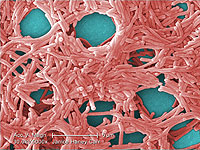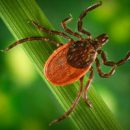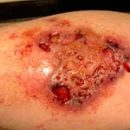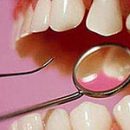Legionellez is a bacterial infection caused by various types of Legionell. What is this disease, what are the mechanism of infection with legionelle and clinical symptoms of legionnaire disease? The danger of infection, and is it possible to defend it from it? Answers to all these questions you will find in the article.
Content
- What is legionell and where he is coming from?
- Face of Legionnai disease
- Is it possible to avoid infection?
 In 1976 in the United States, in Philadelphia among veterans of the participants «American Legion», Conducted in a modern hotel equipped with air conditioning, a strange infection broke out. Two hundred and twenty one person from almost four and a half thousand fell ill with heavy pneumonia, thirty-four of them did not manage to cope with the disease. The name of the non-known disease was given name «Legionnae disease», And the causative agent of pneumonia, isolated from the tissues of the dead patients, received a temper name — «Legionella Hemophilia». Later, scientists have found similarity of the disease with other cases of infection caused by different types of Legionell, and the name «Legionelles» firmly entrenched for all diseases caused by these microbes.
In 1976 in the United States, in Philadelphia among veterans of the participants «American Legion», Conducted in a modern hotel equipped with air conditioning, a strange infection broke out. Two hundred and twenty one person from almost four and a half thousand fell ill with heavy pneumonia, thirty-four of them did not manage to cope with the disease. The name of the non-known disease was given name «Legionnae disease», And the causative agent of pneumonia, isolated from the tissues of the dead patients, received a temper name — «Legionella Hemophilia». Later, scientists have found similarity of the disease with other cases of infection caused by different types of Legionell, and the name «Legionelles» firmly entrenched for all diseases caused by these microbes.
What is legionell and where he is coming from?
Legionelles — This is a bacterial infection caused by various types of Legionell. Today, scientists are known for more than forty species of pathogen, of which twenty-two kinds are dangerous for humans. Most often doctors have to deal with the consequences of infection with legionell hemophilia, which has the ability to allocate specific toxins in the process of life and in death. It is with the action of these toxins that the development of heavy symptoms and complications is connected.
The sick person is not a source of infection, it does not represent danger to others. Legionella live in soil and standing freshwater reservoirs with «blooming» Water. Legionells inhabit cooling systems, cheap installations, swimming pools, decorative fountains, they settle even in hospitals, in devices for balneological procedures and artificial respiratory devices. Microorganism lives almost everywhere where water can be stood, he «Friendy» with water amebami, settled inside them and thus «hide» from the destruction of chlorine and other disinfectants.
Logionelleza infection occurs when inhaling water or water-dust aerosol. Most often, cases of disease among people, often live in hotels, among workers' construction organizations, leading earthworks, but are found and pneumonia arising from therapeutic physiotherapy procedures.
The level of incidence of legionelles in developed countries is much higher than in developing. Flashes are observed mainly in the summer-autumn months, men are twice as often. Among all pneumonia, the share of legionells accounts for up to 5%, and for the most part they are heavy, leading to respiratory failure and complications.
Face of Legionnai disease
According to statistics, legionellles in one form or another develops in 95% of infected, but not all of all it flows in the form of severe lung inflammation. Pneumonia may be easy, alveolite can develop, acute respiratory disease (pontiak fever) or acute feverish disease with Exanthemia (Forta Bragg fever). But the classic version of Legionnaire diseases — This is precisely heavy pneumonia, the picture of which unfolds after 4–7 days after meeting with Legionella.
 Initially, the disease proceeds as an ordinary cold: a headache appears, weakness, the appetite is worse, there may be a disorder. Then the body temperature rises to 39—40 0C and appear signs of severe intoxication: chills, pouring sweats, muscle pain and joints. Weakness becomes so pronounced that the patient is difficult to get out of bed.
Initially, the disease proceeds as an ordinary cold: a headache appears, weakness, the appetite is worse, there may be a disorder. Then the body temperature rises to 39—40 0C and appear signs of severe intoxication: chills, pouring sweats, muscle pain and joints. Weakness becomes so pronounced that the patient is difficult to get out of bed.
Through 3–4 days Pneumonia reaches its heyday, cough appears, first dry, then with a slight amount of mucous-purulent sputum. Against the background of the inflammation of the lungs and the plelev, shortness of breath arise, severe pain in the chest.
Toxic damage to the cardiovascular system is manifested by a drop in blood pressure, the pulse becomes rare and weak. A third of the patients complains of pain and a rumbling in the stomach and liquid chair, possibly developed toxic hepatitis and jaundice.
Against the background of the strongest intoxication, kidney suffer, renal failure is developing. Pneumonia proceeds violently, with difficulty treatable and is often complicated by lung abscesses, exudative pleuritic, infectious-toxic shock leading to the death of the patient.
With a favorable coating of circumstances and recovery in a patient, asthenic syndrome remains for a long time: dizziness, weakness, increased fatigue, reduction of memory, irritability, frequent change of moods.
Is it possible to avoid infection?
In the medical institutions, there are strict records of all cases of legionell pneumonia, in light cases the patients are treated at home, isolation is not required, because Legionella is not transmitted to man. For the same reasons in the room where the patient was lying, the final disinfection was carried out.
Specific prophylaxis of legionelosis does not exist, scientists have not yet invented a vaccine that would protect from legionnaire disease. The main way to combat infection — Sanitary and hygienic control over the condition of air conditioning systems, heating and cooling water, shower plants, pools, physiotherapy equipment and artificial ventilation devices. Disinfection and disinfection again — Only it can reduce the concentration of the causative agent in water systems and thereby reduce the risk of a disease to a minimum.









